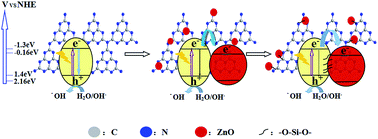Synthesis of silicate-bridged ZnO/g-C3N4 nanocomposites as efficient photocatalysts and its mechanism†
Abstract
In this study, silicate-capped ZnO/g-C3N4 nanocomposites were successfully fabricated by a simple wet chemical process. The photocatalytic activities of g-C3N4 for the degradation of phenol and the production of H2 are greatly enhanced after coupling with an appropriate amount of nanocrystalline ZnO. This is attributed to the prolonged lifetime and increased separation of the photogenerated charges, which are mainly based on atmosphere-controlled steady-state surface photovoltage spectra and time-resolved surface photovoltage responses. Interestingly, the lifetime and separation of photogenerated charges are further improved after the introduction of silicate groups as linkers between ZnO and g-C3N4, which consequently lead to enhanced photocatalytic activities, as much as 4 times higher compared to g-C3N4. Evidently, the built silicate linkers, which act as bridges, are highly favorable for charge transfer and separation in the fabricated heterojunctional nanocomposites and also for efficient photocatalysis. The present work provides a simple and feasible idea to enhance photogenerated charge separation so as to improve the photoactivities of nanocomposites.


 Please wait while we load your content...
Please wait while we load your content...